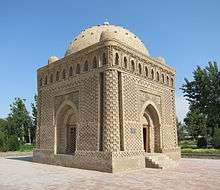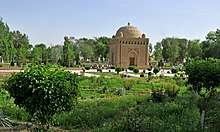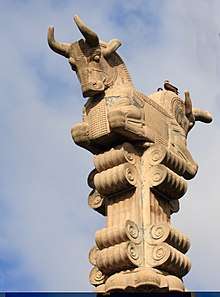Samanid Mausoleum
The Samanid mausoleum, built in the 10th century C.E., is located in the North-Western part of Bukhara, Uzbekistan, just outside its historic center. The mausoleum is considered one of the iconic examples of the early Islamic architecture[1] and is known as the oldest funerary building of the Central Asian architecture.[2] It was built as the resting place of the powerful and influential Islamic Samani family dynasty that ruled from approximately 900 to 1,000.[3][4] The Samanids established their de facto independence from the Abbasid Caliphate in Baghdad and ruled over some areas covered by the modern day countries of Afghanistan, Iran, Uzbekistan, Tajikistan, and Kazakhstan. Perfectly symmetrical, compact in its size, yet monumental in its structure, the Mausoleum not only combined multi-cultural building and decorative traditions, such as Sogdian, Sassanian, Persian and even Classical, but also introduced innovative dome support solution and incorporated features customary for medieval Islamic buildings - circular dome and mini domes, pointed arches, elaborate portals, columns and intricate geometric designs.


History
During the 10th century, Samanid's capital, Bukhara, was a major political, trade and cultural center that patronized science, architecture, medicine, arts and literature.[3] Cultural and economic prosperity was fueled by Samanids' strategic positioning along the trade routes between Asia, Middle East, Russia and Europe. It is believed that the Mausoleum was built to emphasize the dynastic power of the Samani family and to link its history with their newly established capital. There are various estimates by the researchers of when the Mausoleum was built. Some attribute it to the reign of Ismail Samani (reigned 892 - 907 CE),[5][6] a founder of the dynasty (born in 849[7]), some reference Ismail's father, Ahmad,[1] who governed Samarkand. Others attribute the building to the reign of Ismail's grand son, Nasr b Ahmad b Ismail (Nasr II)[1] who ruled 914 - 943 CE.[8] The reason for this later attribution is the lintel board with Kufic script[9] found on the eastern side of the building during the restoration works in 1930s that contained the name of Nasr II. Generally, the building is often referred to as the Ismail Samani Mausoleum with a time stamp from the first part of the 10th century. The tomb contains the remains of the Samani dynasty members. In 1930s, Soviet researchers discovered a copy of a 10th-century Waqf document (copied around 1568[8]) that specified that Ismail Samani donated Bukhara's cemetery Naukanda[1] land for what appears to read as a funerary building for his father, Ahmad, confirming earlier assumptions of a dynastic nature of the monument.[8] At the time of Genghis Khan's invasion into the area, the shrine was believed to had been buried in mud and sand from flooding and landslide and was to for remain so for centuries.[7] Thus, when the Mongol armies reached Bukhara, the tomb was spared from their destruction, unlike most other buildings of that era. For the same reasons, the building was not known to the world until the early 20th century when Soviet researchers rediscovered it.[9] Major exploratory research and excavations took place during 1926 -1928 by the USSR team or architects and researchers.[9] During 1937–1939, the Mausoleum was further studied and major restorations works took place under the leadership of B.N. Zasipkin.[9] Graves of three male bodies have been discovered, one of them is identified as Nasr II (per the lintel board), the other two have not been identified.[1] During the Soviet era, some time after The World War II, the cemetery that surrounded the Mausoleum was paved over, and an amusement park (still in operation) was built next to and around the building.
Significance
The fact that the religious law of orthodox Sunni Islam strictly prohibits the construction of mausoleums over burial places stresses the significance of the Samanid mausoleum, which is the oldest surviving monument of Islamic architecture[6] in Central Asia and the sole monument that survived from the epoch of the Samanid Dynasty. The Samanid Mausoleum might be one of the earliest departures from that religious restriction in the history of Islamic architecture. The shrine is regarded as one of the oldest monuments in the Bukhara region. Samanid Mausoleum appears in virtually every survey on the Islamic architecture and is significant as an example of early Islamic architecture in the Central Asia and worldwide. Its unknown creators harmoniously combined references to the prior regional traditions and deployed innovative structural elements, such as squinches, as well as new for the time features that are considered customary for the Islamic architecture worldwide. Samanid Mausoleum is sometimes referred to as a "Jewel Box" due to its compact size and elegant, mathematically calculated proportions and rhythmic patterns of its intricate, unprecedented baked brick decoration.
Architecture
The monument marks a new era in the development of Persian and Central Asian architecture, which was revived after the Arab conquest of the region. Many researches noted that the structure is made similar to the open, four-arched, often square in shape, Zoroastrian fire temples from Sassanian Iran,[3] commonly known as chahar taq in Persian - a reference to Samanids claim of Sassanian descent.[1] The building's shape is cuboid, like the Kaaba structure of the Great Mosque of Mecca in Saudi Arabia, while heavy fortress-like corner buttresses are derived from Sogdian traditions of Central Asia. The synthetic style of the tomb is reflective of the 9th and 10th centuries - a time when the region still had large populations of Zoroastrians in their early stages of conversion to Islam. Elaborate baked brick decoration is unique in its level of detail and rhythmic patterns and combines multi-cultural decorative motifs (Sogdian, Sassanian, Persian, Arabic, Antique). However, the building architects went beyond simply appropriating existing traditions in building structure and decoration, they introduced new features symbolic for the monumental dynastic architecture. In its structure, Mausoleum's unknown architects used squinches,[6] containing four interior arches[10] and an octagonal structure,[9] that allowed to redistribute the weight of the circular dome over a square base, a predecessor to more sophisticated pendentives.
Overall, the building is constructed in a form of a small, slightly tapering cube, with each side of approximately 31 ft (or 10 meters).[6] There are four identically designed facades which gently slope inwards with increasing height. Wall thickness of approximately 6 ft (1.8 meters)[9] at the base of the building assured structural solidity and survival through the ages. Each side has an entrance portal adorned with pointed arches. Many researches note well studied,[6] almost mathematical,[9] proportions of the building and its harmonious[5] hierarchy.[6] The base of the building is heavy which is accentuated by a wider foundation; four heavy built in three-quarter[11] corner columns, classical in design,[7] contribute to its fortress-like appearance. The top of the building is lightened up through an elegant arcade gallery, placed below the cornice, that have many arched openings to reduce overall weight and to let light inside the building (in contrast, most of chahar taq structures had no windows). A large semi-circular Dome, about 23 ft (7 meters[10]) in diameter crowns the structure and it is similar to the Buddhist domes in the area.[7] Four mini domes placed in the corners of the roof are more decorative in nature. Overall, Mausoleum builders achieved an elegant hierarchy of diminishing proportions and vertical perspective through the diminishing size of the domes (one large and four small), columns (placed in the corners, portals and gallery) and arches (portals and gallery). Typical for Islamic architecture in general, there is an overlap and ambiguity between the structural and decorative features within the building - bricks being structure and décor, both equally important.[12]
Builders used baked brick of various rectangular and square sizes for both structural and decorative elements of the building. Large bricks formed large bands throughout the building for structural stability, smaller bricks were used for decoration, usually in blocks of two to five bricks. Baked brick was a known material in the region, yet such extensive and creative use is considered unprecedented. Local builders mostly used unbaked brick, stucco and wood as these materials were cheaper, but not as strong as baked brick. The Mausoleum uses a few stucco and wood elements but these are minimal in terms of their relative share in the construction process. A few bounding compounds were discovered during the excavations, alabaster being one of them. It is interesting that due to Islamic restrictions on use of imagery, Samanid Mausoleum decoration in mostly geometric in its layout and patterns, in comparison with the pre-Islamic Central Asian building traditions that blended architecture, sculpture and painting.[9] Researchers found common elements between the Samanid Mausoleum décor and design patterns executed in wood from the 8th century Penjikent.[13] Repeat patterns create calculated harmony and a sense of infinity, important for a funerary structure. Patterns of great variety, executed in baked brick include basket weave,[10] checker board, "dog tooth"[10] ornament (on spandrels and the main dome), borders of rosettes, floral ornaments, ribbons, and bands of pearls. There is a notable consistency between the exterior and interior decor in terms of patterns, materials and approach and this signifies that the construction was most likely performed by the same person or team. Repeat pattern of decor and general symmetry were helpful during the restoration works in 1930s as archeologists used surviving elements to restore those that had been lost. Careful studies of the type of materials, mortar, patterns, thickness and forms of historic layers were conducted before the restoration works began.[9] Prior to renovations, most of the damage was located at the gallery level. Some time during the 20th century, metal screens were installed within the portals to restrict access to the building. It is not known if the original portals had any screens installed.
Influence on later architecture
The mausoleum of Pakistan's founding father, Muhammad Ali Jinnah--Mazar-e-Quaid is modeled after this Samanid shrine.
References
- MICHAILIDIS, MELANIE (2014). "Dynastic Politics and the Samanid Mausoleum". Ars Orientalis. 44: 20–39. ISSN 0571-1371. JSTOR 43489796.
- Knobloch, Edgar (1972). Beyond the Oxus: archaeology, art & architecture of Central Asia. Totowa NJ: Rowman and Littlefield. pp. 27–28, 66, 151.
- Michailidis, Melanie (2012). "Samanid Silver and Trade along the Fur Route". Medieval Encounters. 18 (4–5): 315–338. doi:10.1163/15700674-12342119.
- The Princeton encyclopedia of Islamic political thought. Böwering, Gerhard, 1939-, Crone, Patricia, 1945-2015,, Mirza, Mahan. Princeton, N.J.: Princeton University Press. 2013. ISBN 978-1-4008-3855-4. OCLC 820631887.CS1 maint: others (link)
- Pryce, Will. (2008). World architecture : the masterworks. London: Thames & Hudson. p. 32. ISBN 978-0-500-34248-0. OCLC 227016790.
- Pope, Arthur Upham (1965). Persian architecture; the triumph of form and color. New York: G. Braziller. pp. 81–85.
- Starr, S. Frederick. (2013-10-13). Lost enlightenment : Central Asia's golden age from the Arab conquest to Tamerlane. Princeton. ISBN 978-0-691-15773-3. OCLC 840582136.
- Grabar, Oleg (1966). "The Earliest Islamic Commemorative Structures, Notes and Documents". Ars Orientalis. 6: 7–46. JSTOR 4629220.
- Bulatov, M.S. (1976). Mavzoleĭ Samanidov-zhemchuzhina arkhitektury Sredneĭ Azii (Samanid Mausoleum - an architectural jewel of Central Asia). Taskent, Uzbekistan, USSR: Izdatelstvo Literaturi i Iskusstva (Publishinh house of Literature and Art).
- Grube, Ernst J., Michell, George. Architecture of the Islamic world : its history and social meaning. New York. ISBN 0-688-03324-5. OCLC 4401627.CS1 maint: multiple names: authors list (link)
- History of Civilizations of Central Asia. Dani, Ahmad Hasan., Masson, V. M. (Vadim Mikhaĭlovich), 1929-, Harmatta, J. (János), 1917-2004., Puri, Baij Nath., Etemadi, G. F., Litvinskiĭ, B. A. (Boris Anatolʹevich). Paris: Unesco. 1992–2005. ISBN 92-3-102719-0. OCLC 28186754.CS1 maint: others (link) CS1 maint: date format (link)
- Hill Derek, Grabar Oleg (1966). "Islamic Architecture and its Decoration A.D. 800-1500 (A Photographic Survey by Derek HILL. With an Introductory Text by Oleg GRABAR), I vol. petit in-4°, 88 p. et 527 fig. en 144 pl., h.t. + 4 pl. couleurs, Londres (Faber and Faber) 1964". Arabica. 13 (3): 326–329. doi:10.1163/157005866x00606. ISSN 0570-5398.
- Voronina, V. (1969). Architectural monuments of Middle Asia : Bokhara, Samarkand. "Aurora" Publishers. OCLC 4729898.
Further reading
Maqbara-i Ismail Samani | Archnet http://archnet.org/sites/2121
External links
| Wikimedia Commons has media related to Samanid Mausoleum. |
.jpg)
